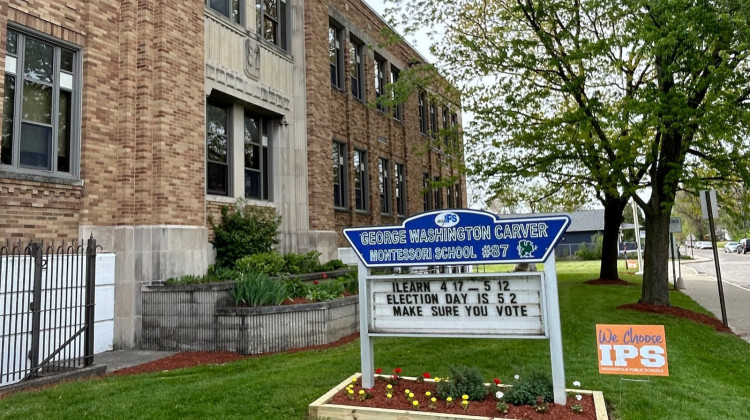
Gov. Eric Holcomb responded to Indiana's literacy decline by setting a statewide goal of 95 percent reading proficiency for all third graders by 2027.
WFIU file photoReading competency for Indiana’s third graders is stagnant compared to the previous year and remains near the lowest point in a decade.
Results released Wednesday found nearly 1 in 5 students failed the test because they have not mastered crucial reading fundamentals like phonics and comprehension. The scores continue an ongoing literacy decline that began before students faced school closures and dramatic disruptions caused by the COVID-19 pandemic. The third graders taking the literacy assessment this past spring and summer were kindergarteners in 2020.
"It is key for us to acknowledge, for schools to acknowledge, we urgently have to overcome this," Secretary of Education Katie Jenner said during the State Board of Education meeting, noting that the state's highest pass rate was 10 years ago.
Statewide, 81.9 percent of the 82,000 third graders at public and private schools passed the 2023 Indiana Reading Evaluation and Determination – or IREAD-3. About 15,000 students did not pass. This is an improvement of 0.3 percentage points over last year's results.
State leaders, educators, and philanthropic groups have rushed to address the state’s literacy decline. Last year, Gov. Eric Holcomb responded by setting a challenging goal of 95 percent reading proficiency for all third graders by 2027.
Leaders are hopeful that a new law mandating a reading curriculum aligned to the science of reading for K-12 students and for people training to be teachers at state colleges will eventually lead to improvements across the state. And a combination of state and philanthropic funds for various programs to support teachers in the instruction method has reached $170 million.
Passing the IREAD-3 assessment a crucial milestone to show whether a student can learn through reading beginning in the fourth grade. Research has found a clear correlation between achieving reading proficiency by the end of third grade and students' ability to absorb and retain knowledge effectively.
A student can start to fall behind academically if they do not master phonemic awareness, reading fluency and other fundamental skills.
The literacy rate for nearly all student subgroups barely improved in the past year, meaning long-standing disparities continue, including the persistent achievement gaps for both race and income levels.
English language learners, and Hispanic and Black students continue to lag the most among subgroups, when compared to their pre-pandemic scores. Black students passed IREAD at 65.6 percent in 2023. And their White classmates continue to pass at a higher rate of at least 19 percentage points compared to most non-white students.
State Board of Education member Scott Bess said the state is in jeopardy if the literacy skills of Hispanic students and others continue to lag. The growing populations, he said, are will be part of workforces required to attract business.
“And I think that's something to really continue pounding the table and waving the flag of, 'We have to do this because the future of this economy in Indiana depends on it,'" said Bess, founder of Purdue Polytechnic charter high school.
Asian students passed at a rate of 85 percent.
Family income is also a divider among students with reading fluency and vocabulary development skills. Students who received free or reduced meals last school year, the national standard for calculating child poverty, passed at a rate of 74 percent. Students who can afford to pay for meals had a competency of 90 percent — the highest among all subgroups.
The traditional school districts with the largest enrollment of third graders had disparate pass rates: Fort Wayne Community Schools, 70.9 percent; Indianapolis Public Schools, 60.6 percent; Hamilton Southeastern Schools, 92.9 percent; and Evansville Vanderburgh School Corp., 74.4 percent. The 75,135 students at public schools passed at a rate of 81 percent.
Among the state’s largest non-public school corporations, pass rates were among the top 80 districts: Diocese of Evansville, 95.3 percent; the Archdiocese of Indianapolis, Diocese of Fort Wayne - South Bend, and Lutheran Schools of Indiana all reported just below 92 percent. The nearly 6,900 students at non-public schools passed at a rate of 92.8 percent.
Just 22 traditional public, public charter, or virtual charter schools and 92 non-public schools had a 100 percent pass rate out of 1,340 total schools. This year’s third-grade reading rate is 9.5 percentage points behind the state's highest pass rate of 91.4 percent in 2012-13.
The 2023 IREAD pass rate includes results from third grade students who passed the test in second grade.
Contact WFYI education editor Eric Weddle at eweddle@wfyi.org or call (317) 614-0470.
 DONATE
DONATE






 Support WFYI. We can't do it without you.
Support WFYI. We can't do it without you.